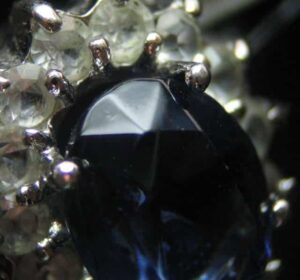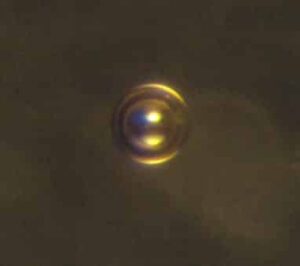
Photo by JB.
Paste is a synonym for glass when used in the context of a gem material. Glass has been used as a gemstone imitation since ancient history for obvious reasons: it’s transparent, can be colored in many ways and resembles all kinds of gemstones when polished.
The first paste ‘forgeries’ are thought to have been introduced into Ancient Greek society although glassmaking had been around for a long time by then.
Paste imitations have been found in archaeological diggings and collections from over the past 2000 years. First as cabochons and beads later as faceted stones as well. In 1674 an English glassmaker, George Ravenscroft (1618-1681), patented a new glass that was made with a higher lead oxide content and had a higher Refractive Index (RI) than before. It was a brilliant glass with high dispersion. All kinds of varieties of composite stones involving paste have been brought on the market. One scheme is more cunning than the other. Paste gemstones can be recognized fairly easily by gemologists who look for gas bubbles, swirly texture and singly refractive stones with a certain range of RI.

Photo by Tim Spauwen.
Glass is an amorphous material; it lacks a repeating, three-dimensional, array of atomic bonding and therefore. In other words: it has a random arrangement of their bonding, it lacks crystal structure. Glass is a result of rapid cooling of molten silicon oxide (SiO2) and a few additives. This rapid cooling prevents the atoms to ‘settle into a regular pattern causing the amorphous structure.
The above has a few consequences: due to the amorphous structure glass is single refractive instead of double refractive like most gemstones it imitates. It isn’t as hard as most crystalline substances it imitates and its not as cold to the touch. This was mentioned by Pliny the Elder in his Naturalis Historia written in the first century AD:
To test the validity of the gem there is several ways the first by it’s weight because the real ones are heavier and then by the temperature, because the real ones feel colder in the mouth.1
Gemological Information for Paste
| Color: | All Colors |
| Crystal Structure: | Amorphous |
| Refractive Index: | 1.47 to 1.76 |
| Durability: | Poor |
| Hardness: | 5 to 6 |
| Family: | |
| Similar Stones: | Imitates Almost Any Gem Material |
| Treatments: | Coatings |
| Country of Origin: | Not Applicable |
Paste Care
| Ultrasonic Cleaning: | Not Safe |
| Steam Cleaning: | Not Safe |
| Warm Soapy Water: | Safe (avoid if foil backed or glued) |
| Chemical Attack: | Easily Attacked (Even by Fumes) |
| Light Sensitivity: | None |
| Heat Sensitivity: | Rapid Heat Change May Cause Fracture, High Heat Will Cause it to Liquify |
Gems & Gemology: The Quarterly Journal of The Gemological Institute of America.
Paste:
- Fall 1949, Goldstone or Aventurine Glass, by Webster, p. 207, 3pp.
- Summer 1957, Glass as a Diamond Substitute, p. 62, 1p.
- Summer 1959, A Yellow-Green Faceted Glass with a Refractive Index Above 1.80, p. 292, 1p.
- Winter 1961, Purpurine Glass in Faberge (Showing Absorption Spectrum), p. 244, 2pp.
- Fall 1962, Cat’s-Eye Glass, p. 338, 1p.
- Summer 1965, Alexandrite Colors in Glass, p. 315, 2pp.
- Summer 1968, Identifying Glass vs. Textite, p. 314, 2pp.
- Spring 1971, An Unusual Crystal Type Glass with Dendritic Inclusions, p. 279, 2pp.
- Summer 1971, Lacy Stringers of Bubbles in Glass, p. 318, 1p.
- Summer 1971, Crystalites in Glass, p. 323, 2pp.
- Spring 1972, Crystalites in Glass, p. 23, 1p.
- Fall 1972, Aventurine Glass with Specular Hematite Inclusions, p. 87, 2pp.
- Winter 1972, Fine Cat’s-Eye Glass with Milk and Honey Effect, p. 108, 1p.
- Spring 1973, Jade imitation in Devitrified Fibrous Glass, “Meta Jade” or “Imori Stone,” p. 134, 2pp.
- Spring 1973, “Meta Jade” is Devitrified Fibrous Glass, p. 146, 1p.
- Summer 1973, “Meta Jade” is Devitrified Fibrous Glass (warm to touch), p. 177, 2pp.
- Fall 1973, Alexandrite-Like Glass, p. 203, 2pp.
- Fall 1974, Crystal Groups in Sheaves in Glass, p. 346, 2pp.
- Summer 1975, The “Mood Stone”–Quartz Top and Epoxy Back in Closed Setting, p. 59, 3pp.
- Summer 1975, Black “Meta Jade” or “Imori Stone,” p. 61, 2pp.
- Spring 1976, Opal-Like Glass, p. 155, 1p.
Notes
- Pliny the Elder, Naturalis Historia, Translation by van Gelder, Nieuwenhuis and Peters, Published by Polak & van Gennep, Amsterdam 2005.↵